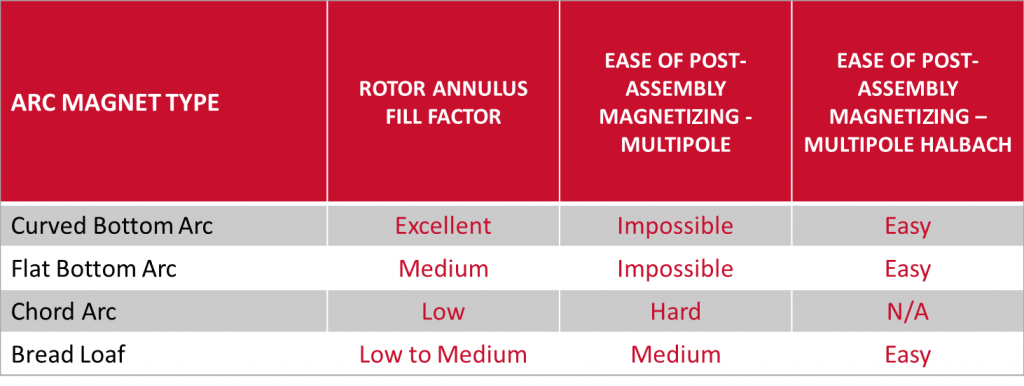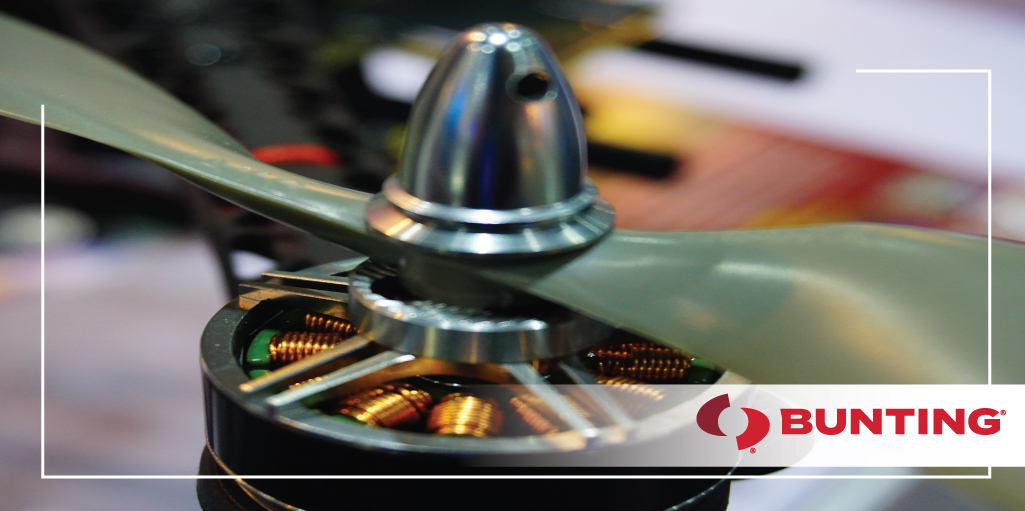Bunting has the capability to supply almost any shape and size of custom designed permanent magnet. One of the most popular shapes is the arc. Arc magnets are used in a wide array of magnetic assemblies, particularly surface mounted electric machines.
There are four main types of arc magnets:
Curved Bottom Arc
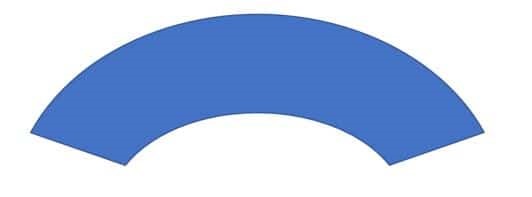
Chord Arc

Flat Bottom Arc
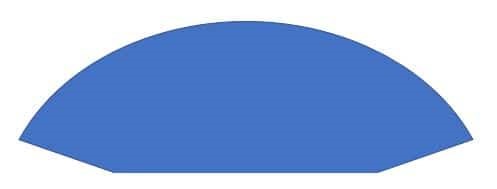
Bread Loaf

Each of these arc types have different advantages and disadvantages when considering the impact on the design of an electric machine. As shape is fundamental to the performance, priority is given to selecting the optimum arc design rather than focusing on production costs. The cost of the magnet materials are typically far higher than the production costs. The magnet’s profile only becomes an issue when producing magnets in very high volumes.
Typical Arc Magnets
The below table is a simple guide to some of the characteristics of various arc magnet types.
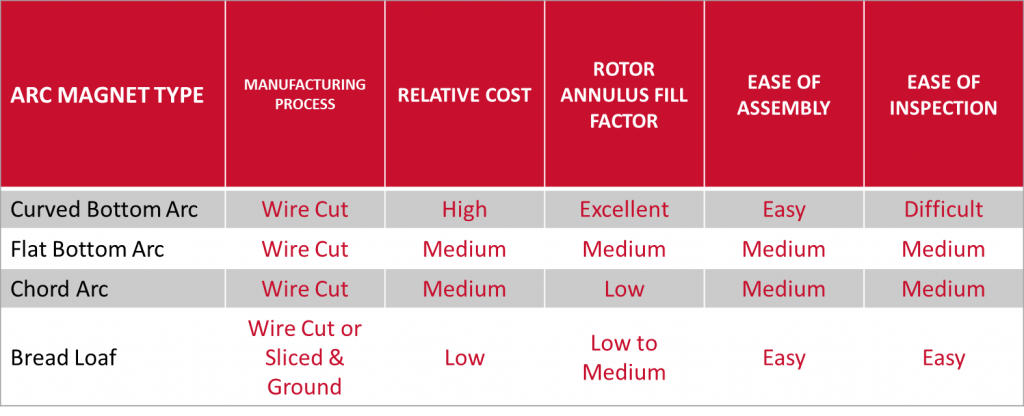
Assembly
During the design stage, the focus is on the permanent magnet rotor’s performance. After confirming the optimum magnetic design, the design team then works alongside the production team to consider the assembly (i.e., the process by which the magnets are secured to the shaft). Then, there are two options for the assembly:
- Assemble using charged magnets. Charged magnets present inherent difficulties, as they are incredibly brittle and their high magnetic strength poses serious safety concerns;
- Following the introduction of new production techniques, Bunting will provide a post-assembly magnetizing solution.
Assembly Using Charged Magnets
The most controlled, lowest risk option for magnetized magnet build is a flat bottom magnet touching down onto a flat surface. However, doing this requires a more expensive, more complex faceted shaft onto which to mount the magnet. In contrast, when using a simple magnet arc, with a round internal diameter (ID) matched to a plain shaft outer diameter (OD), the machining costs of that shaft are significantly lower.
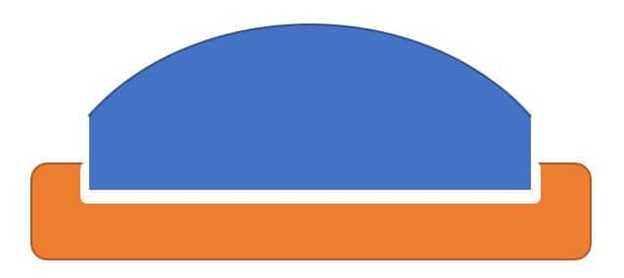
Additionally, to enable ease of assembly, a faceted shaft may have a small recess where the magnet may be mounted. This does increase production costs, but has the benefit of ensuring the magnet does not hang over a faceted surface, as that would prevent the next magnet along from correctly fitting into its position.
Post Assembly Operations
Producing a tight concentricity tolerance or a final OD tolerance for the profiles of arc magnets adds an additional layer of complexity to assemblies.
A “Curved Bottom” arc magnet will not require any more processing and will be immediately ready for grinding.
A “Flat Bottom” arc magnet will not require any more processing and will be immediately ready for grinding.
A “Chord” arc magnet presents a challenge when ready for grinding. Should the magnet move across the whole width of a 4-plus faceted shaft, the shaft starts to be exposed as the rotor is ground. The grinding operation will then be over two dissimilar metals.

A “Bread Loaf” arc magnet presents the greatest manufacturing challenge. Once it is mounted on the shaft, the edges of the arc magnet are exposed—meaning, there is no longer a smooth transition around the rotor’s OD. Since magnets are very brittle and very easily damaged, the gap created by the magnet arc choice must be filled with a material that is reasonably hard, but still easily worked. This material fills the void before being ground back, and stays in position when rotating.

Magnet Containment
For any sort of circumferential containment (such as when using carbon fiber), similar manufacturing considerations apply. It is imperative for the magnet rotor to have a smooth, round surface prior to the wrap being applied, whether carbon fiber (wrapped or pressed) or a heat-shrunk metallic tube.
Magnetizing
Bunting’s technical engineering team has developed technology for post-assembly magnetization with the aim of simplifying the manufacturing process and improving safety. Subsequently, a complex magnet assembly is constructed unmagnetized and then charged later. Post-assembly magnetization presents many advantages. It makes constructing a magnet assembly easier and much faster. This method also reduces the risk of mistakes occurring during assembly, such as incorrect polarity orientation. Post-magnetization means that the magnetic field and polarity are exactly as required for every magnetic component. To read more about the benefits of post-assembly magnetization, please reference the technical article “‘Post Assembly Magnetization for the Automotive Sector.”
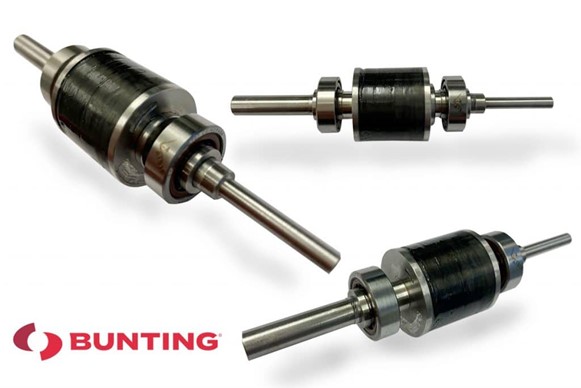
It is not possible to post-assembly magnetize a magnet rotor that comprises of “curved bottom” and “flat bottom” arc magnets. This is because it is impossible to fully magnetically saturate “curved bottom” and “flat bottom” arc magnets.
Post-assembly magnetization is possible when there is a small air gap between “chord” arc magnets and “bread loaf” arc magnets. However, when a transition magnet is introduced and a Surface Mount Halbach rotor is created, magnetizing becomes not only possible, but also greatly simplified.
